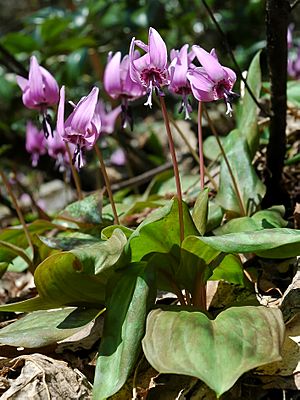Erythronium japonicum facts for kids
Quick facts for kids Erythronium japonicum |
|
|---|---|
 |
|
| Scientific classification | |
| Genus: |
Erythronium
|
| Species: |
japonicum
|
| Synonyms | |
|
|
The Asian fawnlily, known scientifically as Erythronium japonicum, is a beautiful pink-flowered plant. It belongs to the Lily family. You can find this plant growing naturally in Japan, Korea, the Russian Far East (like Sakhalin Island and the Kuril Islands), and northeastern China.
This plant is a spring ephemeral. This means it blooms for a very short time in spring, usually from April to June, in woodlands. In different countries, it has different names: zhūyáhuā (猪牙花) in Chinese, eolleji (얼레지) in Korean, and katakuri (片栗) in Japanese.
The Asian fawnlily has a stem that can grow up to 20 centimetres (7.9 in) long. About 30% of its stem can be hidden underground. Its bulb is long, up to 6 cm (2.4 in) long, but usually less than 1 cm wide (0.39 in). The leaves are wide and oval-shaped, up to 12 cm (4.7 in) long and 7 cm (2.8 in) wide. Each plant usually has one rose-colored flower.
Sometimes, this plant is called a trout lily. However, this name might be a bit confusing for the Japanese species. Trout lilies often have dark spots on their leaves, like a trout fish. But the Asian fawnlily might not have these spots.
Protecting the Asian Fawnlily
People have different ideas about whether the Asian fawnlily is in danger in Japan. Some say it should be on a list of endangered wildflowers. Others say it is not endangered.
The Japanese Ministry of the Environment has not made a decision for the whole species. However, in some areas, like Hyōgo and Mie, it is considered "near threatened." This means it could become endangered if not protected. In Shikoku and southern Kanto, it is seen as vulnerable or endangered.
This woodland plant is quite delicate. It only blooms for a short time each year and grows very slowly. It takes 7 to 8 years for a plant to grow big enough to flower for the first time. Because of this, if many plants are taken from the wild, their numbers will not recover quickly. For example, in one area called Niiharu, a whole group of these plants was taken from the wild overnight after news spread that they were blooming there.
If you want to see a group of these plants in Tokyo, you can visit Shimizuyama-ikoi-no-mori. This place is also near the Tomitaro Makino memorial garden, which has a few plants too.
Uses of the Plant
The starch called katakuriko (片栗粉 ("katakuri powder")) gets its name from this plant. Originally, this starch was made from the bulb of the Erythronium japonicum plant.
However, it was hard to get a lot of this starch. So, today, most katakuriko is actually made from potato starch. The original starch from the Asian fawnlily is not common anymore.
People do not usually farm this plant. Sometimes, people illegally take these plants from the wild. They are often wildflower fans or people who sell plants, not usually people looking for starch.
In the past, the powder from this plant was also used as a cream to treat skin rashes.
Images for kids
See also
 In Spanish: Katakuri para niños
In Spanish: Katakuri para niños




